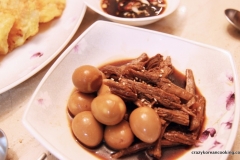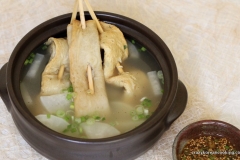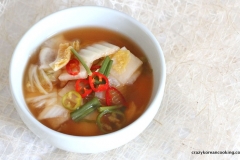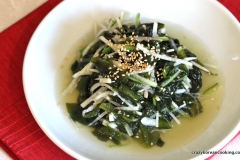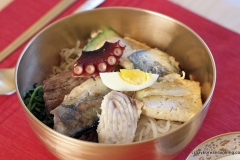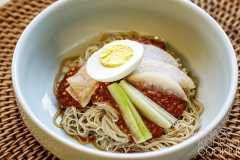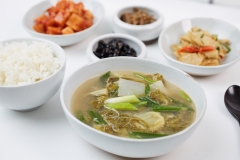Korean Radish 무
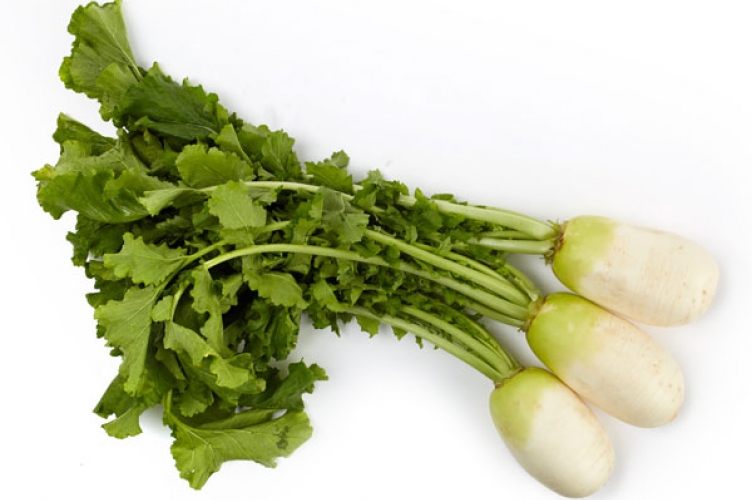
Korean Radish (mu) (무) [moo] is a root vegetable available in several varieties, dependent on size, color, and cultivation method. Compared to a Western radish, a Korean radish is generally much longer and bigger. Mu is white throughout, except where it becomes slightly green toward the top or stem. When washed, it should be firm and shiny.
Though similar in taste and look to daikon (Japanese radish), mu is generally shorter and rounder than daikon. Its also slightly green toward the top, whereas daikon is white throughout. Its texture is denser than daikon, and its flavor is stronger.
Raw mu has peppery taste with a hint of sweetness. (Good quality mu has more sweetness than bitterness.) It can be consumed raw or cooked; when cooked, the spicy taste disappears.
Among its many uses are as a main ingredient for kkakdugi (radish kimchi), baechu kimchi (cabbage kimchi), beef soup, and seasoned radish (musengchae). Mu is also an important ingredient in making soups, stews, broths and braised dishes, because it imparts a refreshing taste.
Buy Korean ingredients online here.
Sourcing & Selecting
Mu are available at Korean, Chinese, and other Asian supermarkets. When selecting, look for firm green stems, thick roots, and very little root hair.
1 radish is about 2-3 pounds or 0.9-1.36 kilograms
1 cup of sliced radish weighs about 116 grams
7-inch long Korean radish weighs about 338 grams
Do not wash mu before storing. Like potatoes, radishes exposed to moisture may grow shoots or rot. Instead, wrap the mu in newspaper and store it in the refrigerator. If you have a crisper in the refrigerator, place it in there.
If you want to freeze mu, first wash it, peel it, and then cut it into small pieces. Seal tightly in a plastic bag. Keep in mind that frozen mu can be used only for soups and stews, because it becomes soft upon defrosting.
Wash thoroughly. |
|
Peel or scrub. |
|
Cut off the stems and root end. |
|
Cut into smaller pieces according to the recipe. |
|
Mu are sold fresh and contain lots of ascorbic acid, folic acid, and potassium. They are also a good source of vitamin B6, riboflavin, magnesium, copper, and calcium.
Mu contains the enzyme myrosinase, which assists the digestive process, especially with starchy food, and also helps with detoxification. It's also good for those on a diet since it is low in food energy. A 100 gram serving only yields 18 calories, while providing 27% Daily Value of Vitamin C.
Value per 100g
Proximates
Water g 94.62
Energy kcal 18
Protein g 0.6
Total lipid (fat) g 0.1
Carbohydrate, by difference g 4.1
Fiber, total dietary g 1.6
Sugars, total g 2.5
Minerals
Calcium, Ca mg 27
Iron, Fe mg 0.4
Magnesium, Mg mg 16
Phosphorus, P mg 23
Potassium, K mg 227
Sodium, Na mg 21
Zinc, Zn mg 0.15
Vitamins
Vitamin C, total ascorbic acid mg 22
Thiamin mg 0.02
Riboflavin mg 0.02
Niacin mg 0.2
Vitamin B-6 mg 0.046
Folate, DFE µg 28
Vitamin B-12 µg 0
Vitamin A, RAE µg 0
Vitamin A, IU IU 0
Vitamin E (alpha-tocopherol) mg 0
Vitamin D (D2 + D3) µg 0
Vitamin D IU 0
Vitamin K (phylloquinone) µg 0.3
Lipids
Fatty acids, total saturated g 0.03
Fatty acids, total monounsaturated g 0.017
Fatty acids, total polyunsaturated g 0.045
Cholesterol mg 0
Other
Caffeine mg 0















